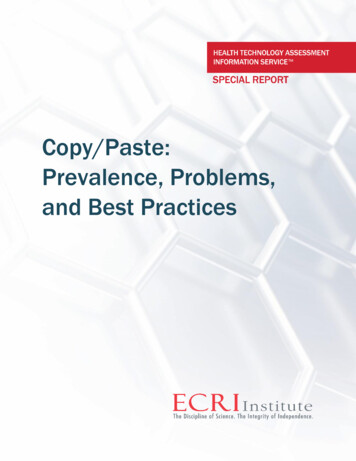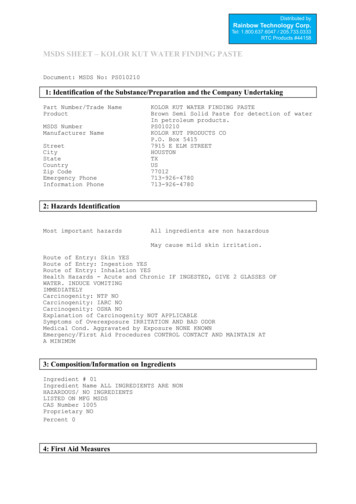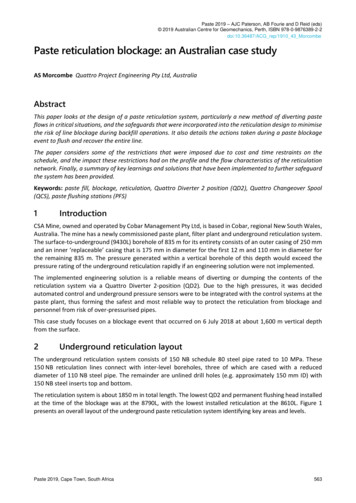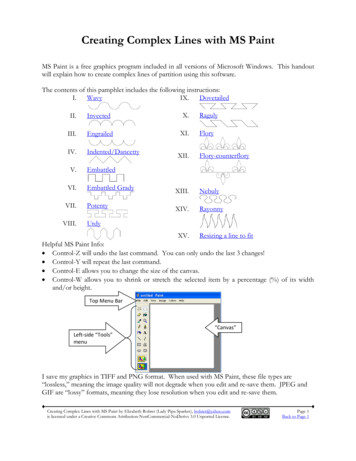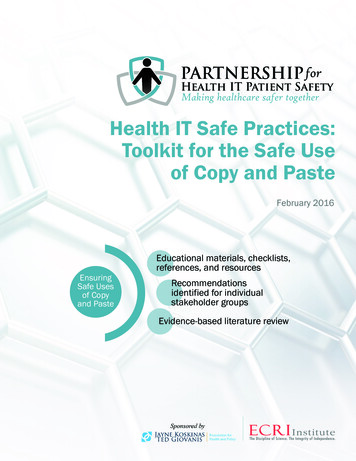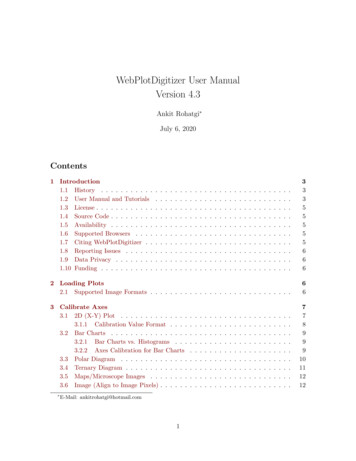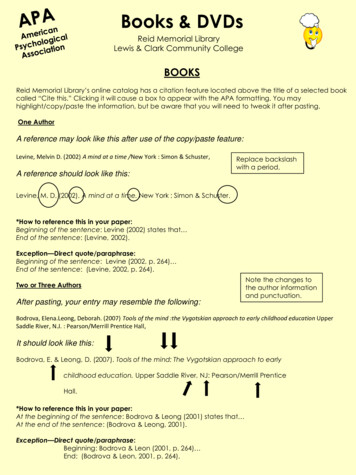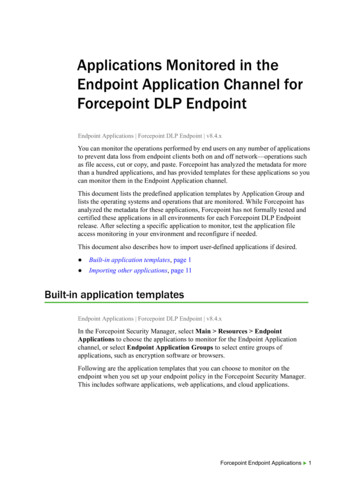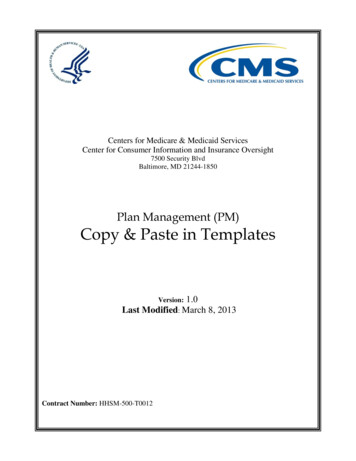
Transcription
Centers for Medicare & Medicaid ServicesCenter for Consumer Information and Insurance Oversight7500 Security BlvdBaltimore, MD 21244-1850Plan Management (PM)Copy & Paste in Templates1.0Last Modified: March 8, 2013Version:Contract Number: HHSM-500-T0012
Plan Management (PM)Table of Contents1. Copying and Pasting in Plan Management Templates . 41.1.1.2.1.3.1.4.1.5.General Copy/Paste Recommendations. 4Whole Template Copy/Paste Recommendations. 4Column Level Copy/Paste Recommendations . 4Row Level Copy/Paste Recommendations. 4Cell Level Copy/Paste Recommendations. 52. Administrative Data Template . 53. Essential Community Providers (ECP), NCQA, URAC, Network ID Templates . 64. Prescription Drug Template . 75. Service Area Template . 76. Rating Tables Template . 86.1.6.2.Issuers in Individual Rated States . 8Issuers in Family Tiering States . 97. Rating Business Rules Template . 108. Plans & Benefits Template . 11Copy & Paste in Templates 1.0 / March 8, 2013ii
Plan Management (PM)Table of FiguresFigure 1: Paste Special Menus . 5Figure 2: Column Headers and Title Fields . 5Figure 3: ECP Template. 6Figure 4: Prescription Drug Template . 7Figure 5: Service Area Template . 8Figure 6: Rating Tables Template with Age Bands and No Preference Tobacco Option . 8Figure 7: Rating Tables Template with Separate Rates for Tobacco Use . 9Figure 8: Rating Tables Template Displaying Family Tiering Columns . 9Figure 9: Rating Table Template Showing Adjacent Cells that Cannot be Copied . 10Figure 10: Rating Business Rules Template – Relationship to Primary Pop-up . 11Figure 11: Plan & Benefits Template Showing Plan Level Data . 11Figure 12: Plan & Benefits Template - Bottom EHB Table . 12Figure 13: Sample Excel Error Message . 12Figure 14: Benefits Template Cost Share Variance Sheet Sample Benefit Columns. 12Figure 15: Subsection of Benefits Template . 13Figure 16: Benefits Template Deductible Columns Selected for Copy . 13Figure 17: Benefits Template Deductible Columns After Paste Values . 14Figure 18: Benefits Template Tier 2 Benefit Columns . 14Copy & Paste in Templates 1.0 / March 8, 2013iii
Plan Management (PM)1.Copying and Pasting in Plan Management TemplatesCopy/pasting is permitted in all the Plan Management templates required as part of the QualifiedHealth Plan (QHP) submission. To ensure users do not run into issues while preparing data fortemplates, there are a few key points to keep in mind when pasting data into macro-enabledtemplates.1.1.General Copy/Paste Recommendations Excel Pasting and Cell Validation: In Excel, pasting into templates causes your cell levelvalidations to be over-written, which could lead to validation errors. The Data TraceabilityMatrix of each QHP module documents the formats, allowable values, and requiredelements for all of the templates. Recommendation: Ensure that the data you are pasting is the correct type of data for thecell. For example, if the template is expecting a text value, ensure the source data is textand not numeric. Errors that normally would be caught on manual entry will be checkedwhen the template is validated. If at all possible, use the Paste/Paste Special, and selectValues radio button. Note: If you have a numerical identifier with a leading zero, it is permissible to copy it astext and paste it into a numerical field. Excel automatically drops leading zeros unless afield is specifically formatted. So for example, if you have a TIN number that starts with azero, you may copy the number (formatted as text to keep the leading zero) and paste it intothe template. Leading zeros will not create validation errors.1.2.Whole Template Copy/Paste Recommendations Column headers of all the templates are locked; you cannot select an entire template, withheaders, and paste into a new one. In some templates, there may be hidden columns that would block you from pasting anentire row in (Rating Tables is an example).Recommendations: Select only the fields with user entered data to copy and paste. If youreceive the Excel error that you are trying to paste into a protected cell, look at the specifictemplate guidelines in this document.1.3.Column Level Copy/Paste Recommendations Only copy user entered data, and do not include the header columns or any grey filled cells.Columns may not be deleted, but you can adjust the width of a column to better view data.1.4.Row Level Copy/Paste Recommendations Only copy user entered data, and do not include any green label fields from a row. Entirerows can be deleted in most templates, but you cannot delete a row that has a locked cell init.Copy & Paste in Templates 1.0 / March 8, 20134
Plan Management (PM)1.5.Cell Level Copy/Paste Recommendations If a cell is locked (on most templates, locked cells are grey,) you cannot paste into it.Recommendation: For all unlocked cells, use the Paste Special Values button.2.Administrative Data TemplateThe Administrative Data template resembles a paper form, and therefore a large portion ofthis template has locked cells. You can paste into individual cells requiring input, preferablyusing the Paste Values option (see Figure 1), which can be accessed from the right clickmenu or from the Excel ribbon.Figure 1: Paste Special MenusIf you have an older version of the template that you want to copy from, you can select anyadjacent cells with user entered data and copy into the latest version. As long as you do notinclude a locked cell, it will paste correctly. The column headers and title fields that have a greenfill, as shown in Figure 2, are always locked.Figure 2: Column Headers and Title FieldsCopy & Paste in Templates 1.0 / March 8, 20135
Plan Management (PM)3.Essential Community Providers (ECP), NCQA, URAC, NetworkID TemplatesThese four templates are simple tables and have no locked cells where users would enter data.You may copy/paste into any of these cells, but be sure to paste the correct type of data. Checkthe Data Traceability Matrix for specific data formats. For any cells that are drop-downs, makesure you are pasting one of the options listed in the drop-down; otherwise, validation errors willoccur. The Validate macro of all templates is not case sensitive in regards to the drop-downvalues. However, some templates have automated functions that will not trigger, if you pastevalues, or will not trigger properly if the wrong case is used. For example, in the Service Areatemplate, if you paste “yes” into Partial County, it will not trigger the macro that un-hides thePartial County Zip Codes column. For best results, use the case that is given in the templates orData Traceability Matrix.Network and Essential Community Providers both use the Network ID field. The recommendedapproach is to create your Network IDs (based on your state) with the Create Network IDs buttonin the Network ID template prior to filling out data in the ECP Template, shown in Figure 3, toensure the enumeration of the Network IDs on both templates match.One solution for copy/pasting in the ECP Template, if multiple providers are in the samenetworks, may be to use the pop-up one time, to select the Network IDs and then copy/paste toall other providers that use those networks. As with the Administrative Data template, if youhave older versions of the templates already filled in, you may paste the data into the latestversion. Make sure to select information starting from underneath the headers; otherwise youwill be trying to paste into locked cells and will receive an Excel error (see screenshot below –highlighted cells are where you should copy from).Figure 3: ECP TemplateCopy & Paste in Templates 1.0 / March 8, 20136
Plan Management (PM)4.Prescription Drug TemplateThe Prescription Drug Template has two types of worksheets, the Formulary Sheet and the DrugList Sheet. The Formulary Sheet of this template has many grey/locked cells. Each formulary isdesigned to always take up 7 rows. Unused tiers in the formulary are grey/locked based on the“Number of Tiers” column. It is best to first select a Formulary ID from the drop-down list (aftercreating Formulary IDs), then enter the URL and select the drug list and number of tiers from thedrop-down. This will grey and lock cells that are not required for input. Anything that is not greycan be pasted into.Figure 4: Prescription Drug TemplateThe Drug Lists sheet has no locked cells, so it is completely acceptable and recommended, topaste a list of RxCUIs into column A. You may also paste the Tier Level and Prior Auth/StepTherapy Required columns. There can be no duplicate RxCUIs; if there are, the error messagewill tell you the cell location of the duplicate. Also be aware, that validation will check that thetier you have selected for a drug actually exists in the formularies that use it. So if your firstformulary uses Drug List 1 and has 5 tiers, you cannot mark any RxCUIs in that drug list asbeing in tier 6 or 7. You can select them as NA if those drugs are used in a different Drug List.5.Service Area TemplateThe Service Area template, shown in Figure 5, will grey and lock cells based on options selectedin the columns. There are hidden columns that will only display if you have a service area thatcovers a partial county. If a cell is grey, you will not be able to paste into it. Also make sure, ifyou are pasting in a long list of zip codes for the Service Area Zip Code(s) column, that they areseparated by a comma and space. You only need to list zip codes if the service area covers apartial county (Partial County YES). If Partial County NO, the Service Area Zip Code(s)column is grey and locked so nothing can be pasted in, because zip codes are not needed forservice areas covering entire counties.Copy & Paste in Templates 1.0 / March 8, 20137
Plan Management (PM)Figure 5: Service Area Template6.Rating Tables TemplateThe Rating Tables template is designed to support Issuers submitting for both Individual Ratedand Family Tiering States.6.1.Issuers in Individual Rated StatesRate information may be copy/pasted into Rating Tables. Note that the Rating Tables template isdesigned with significant automation to help users fill in valid information. For example, themacros automatically create all Age Bands required for a plan when the 0-20 option is selectedunder the Age header in Column D. Selecting the 0-20 option will grey and lock a large portionof the cells below the first three columns. There are a few different scenarios to keep in mind. Ifyou use No Preference for Tobacco and select the 0-20 age band, the template will auto populateall the required age bands as well as the Plan ID, Rating Area ID, and Tobacco (see Figure 6).Figure 6: Rating Tables Template with Age Bands and No Preference Tobacco OptionIn this instance, the only cells that can be pasted into are the Individual Rate column cells. Whilethe Age column is not greyed or locked, the age bands are auto-populated and should not beedited.If you select Tobacco Use/Non-Tobacco Use, the Individual Tobacco Rate column will unhide.Copy & Paste in Templates 1.0 / March 8, 20138
Plan Management (PM)Figure 7 shows the Rating Tables template with separate rates for non-tobacco and tobaccousers.Figure 7: Rating Tables Template with Separate Rates for Tobacco UseIn this instance, the cells you will be able to paste into are the Individual Rate and IndividualTobacco Rate.6.2.Issuers in Family Tiering StatesYou may copy into selected cells within the row for plans in states with Family Tiering. If youselect Family Option from the dropdown in the Age column, the template will unhide the familytiers column. Tobacco must be “No Preference” in this case, so the Individual Tobacco Ratecolumn will be hidden.Figure 8 shows the Rating Tables template with Family Tiering columns displayed.Figure 8: Rating Tables Template Displaying Family Tiering ColumnsIn this instance, because there is a hidden column, you would not be able to paste into the wholerow all at once. You can still paste rates into the Individual Rate column, (Column E) and in allthe family tier columns, (Columns G-M), but not in these two adjacent cells at once (see Figure9).Copy & Paste in Templates 1.0 / March 8, 20139
Plan Management (PM)Figure 9: Rating Table Template Showing Adjacent Cells that Cannot be Copied7.Rating Business Rules TemplateThe Rating Business Rules template is, for the most part, a simple table. However, the first rowis considered the “Issuer” rule and therefore the Plan and Product ID columns are grey andlocked. It is required to enter every column in the first row (except for Plan/Product ID). Forevery row after that, you may paste in the Plan OR Product IDs and any columns that havedifferent rules from the first “Issuer” rule.The last column, “What relationships between primary and dependent are allowed, and is thedependent required to live in the same household as the primary subscriber?” is a large pop-up. Itis advisable to always use the pop-up for this column because of the complexity of the dataelements. It is not necessary to enter the same rules repeatedly, so if plans and products have thesame answer to this column as the Issuer rule, they can be left blank. If you are copying datafrom an older version of the template, though, it would be permissible to copy and paste this cell.Figure 10 shows the Rating Business Rules template.Copy & Paste in Templates 1.0 / March 8, 201310
Plan Management (PM)Figure 10: Rating Business Rules Template – Relationship to Primary Pop-up8.Plans & Benefits TemplateIn the Plans & Benefits template, shown in Figure 11, there are places that are fairly easy to pasteinto and others that are not. The top table in the Benefits Package sheet contains high-level planinformation. Any of this information can be pasted in below the header rows.Figure 11: Plan & Benefits Template Showing Plan Level DataThe bottom table in the Benefits Package sheet contains benefit information and EHB data. Thebenefits are locked cells, as well as the EHB/State Mandate columns. It is not possible to pasteinformation into these columns. The Add Benefit macro will assist you in adding extra benefits,but you will be unable to paste over any listed benefits. From column E onward, it is possible topaste data. The Limit Unit column is a pop-up with two drop-downs that allow you to select theunit of limitation. Be aware that if you paste a limit unit that is not in the pop-up, you willreceive a validation error.Copy & Paste in Templates 1.0 / March 8, 201311
Plan Management (PM)Figure 12: Plan & Benefits Template - Bottom EHB TableThe Cost Share Variances sheet is much more complicated to paste into. The first four columnsare protected and read-only. The macros will populate this information, and it is not editable.Based on answers to columns G, H, and I, rows are greyed out and locked that are not applicable.If you are trying to paste any information into a row that has a grey cell, you will receive theExcel error message, shown in Figure 13.Figure 13: Sample Excel Error MessageYou can paste values into any adjacent cells that are not grey, but be very careful to paste theright type of data. Each of the benefits listed on this sheet contains a Copayment andCoinsurance section.Figure 14 shows Benefits Template Sample columns for Primary Care Visit to Treat an Injury orIllness with Copay and Coinsurance columns.Figure 14: Benefits Template Cost Share Variance Sheet Sample Benefit ColumnsCopy & Paste in Templates 1.0 / March 8, 201312
Plan Management (PM)Make sure if you are pasting data that you paste the correct type (whole dollar amount orpercentage) to reduce error messages when you validate.If you need to paste a large block of data, it is easiest to do before the template locks cells thatare not applicable, for example, if you have an older version of the Benefits template that youwant to paste information from.1. On the Cost Share Variance sheet that you want to paste into, delete values from columnsG, H, and I in each row that you want to paste data into, as shown in Figure 15. This willclear out any locked cells on that row.Figure 15: Subsection of Benefits Template2. Select and copy the block of data you want to paste into the template (see Figure 16.) Ifyou are using an older version of the Benefits template, remember that you will not be ableto copy the entire row, because the first four columns are locked. Also remember thatcolumns or data elements may be in different places. It is permissible to copy grey cells, aslong as you paste values only.Figure 16: Benefits Template Deductible Columns Selected for Copy3. Paste Special Values into the destination workbook (either on the Home tab or with theright click). Repeat as many times necessary. (See Figure 17.)Copy & Paste in Templates 1.0 / March 8, 201313
Plan Management (PM)Figure 17: Benefits Template Deductible Columns After Paste Values4. When you are finished pasting, go back to columns G, H, and I and select from the dropdowns. Cells that are not applicable based on these values will grey and lock.5. It is permissible to have a value in a cell before it is grey/locked. For example, each of thebenefits has an In Network Tier 2 column (see Figure 18.) You may fill out all cells withvalues. When you select Multiple In Network Tiers NO, all In Network Tier 2 cells willgrey and lock. Any values in them will still be present, but the template ignores any cellswith a grey fill for both Validate and Finalize.Figure 18: Benefits Template Tier 2 Benefit ColumnsFor best results, do not paste your answers into columns (G, H, I). If you do, it will not triggerthe grey/locking of columns that do not apply. If a cell is not grey, it is required to enter datainto it. For example, if you paste in Yes for Medical & Drug Deductibles Integrated, the templatewill not block out the separate Medical and Drug deductible groups and you will have to enter“Not Applicable” for each column under those groups. It is very important to double check allyour data after pasting into the Cost Share Variance sheet.Copy & Paste in Templates 1.0 / March 8, 201314
1.3. Column Level Copy/Paste Recommendations Only copy user entered data, and do not include the header columns or any grey filled cells. . Figure 3: ECP Template . Plan Management (PM) Copy & Paste in Templates 1.0 / March 8, 2013 7 4. Prescription Drug Template The Prescription Drug Template has two types of worksheets, the Formulary Sheet .
